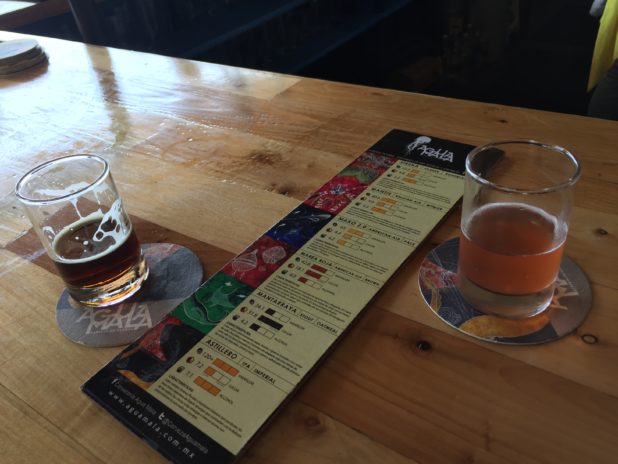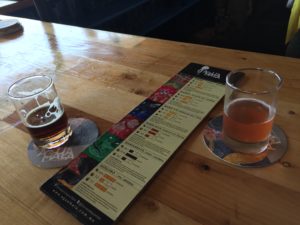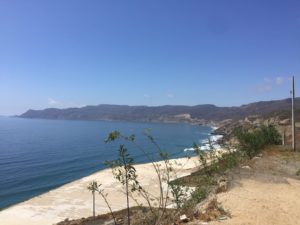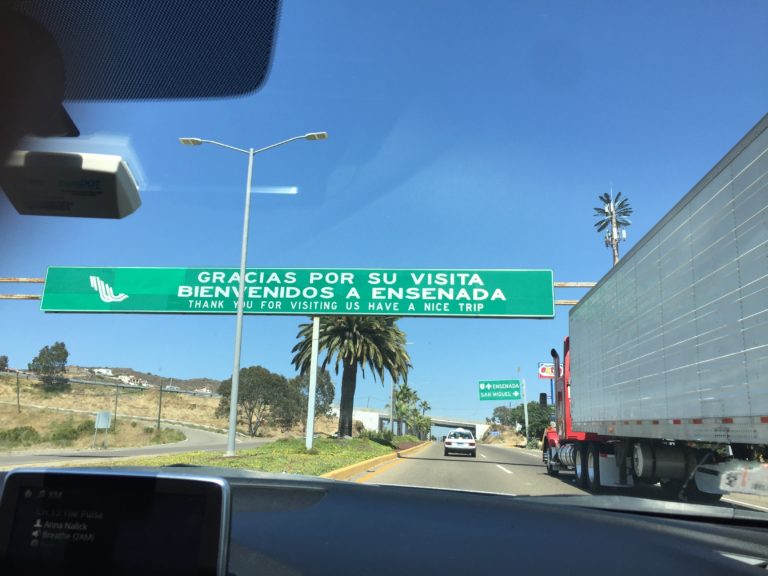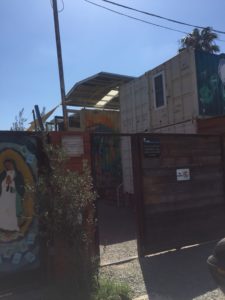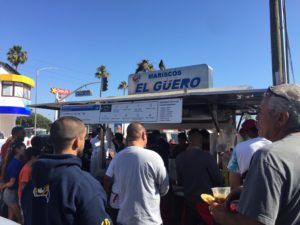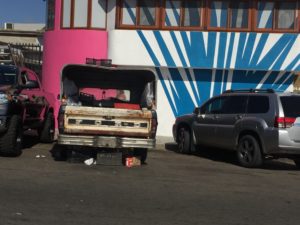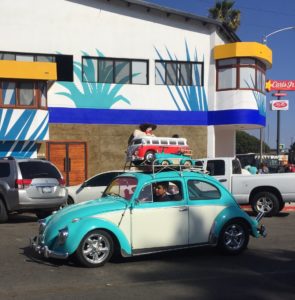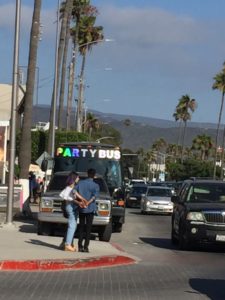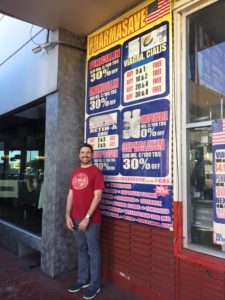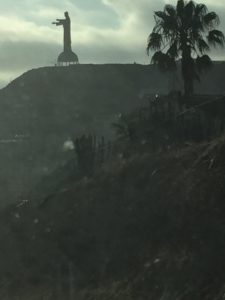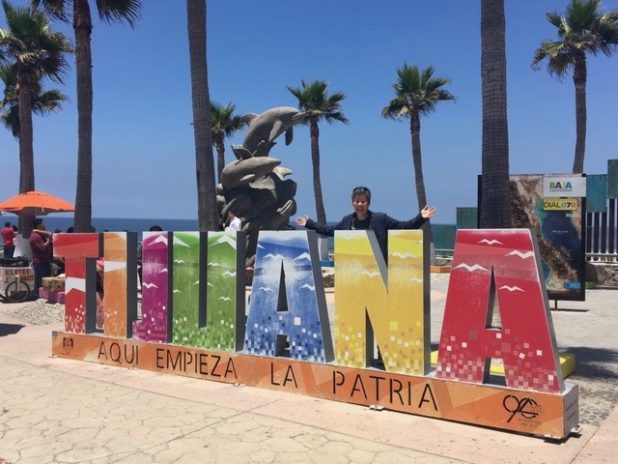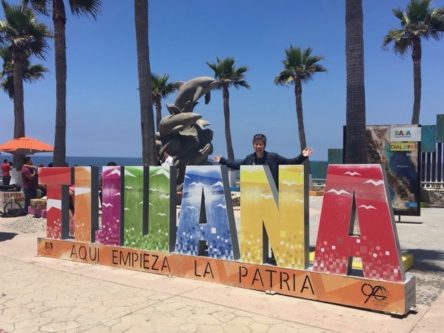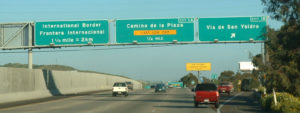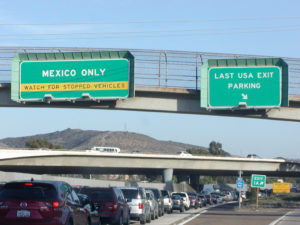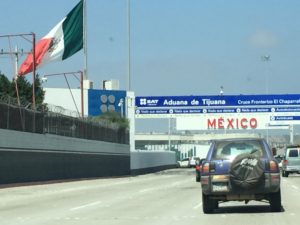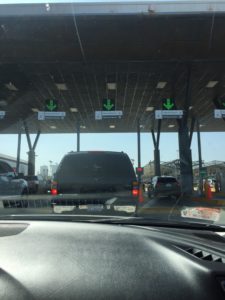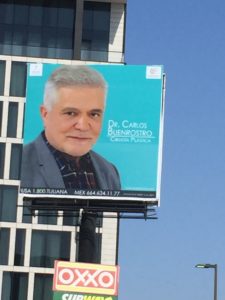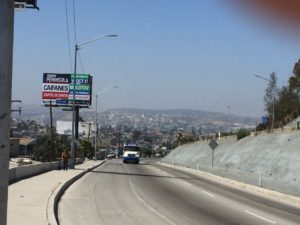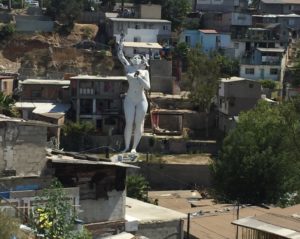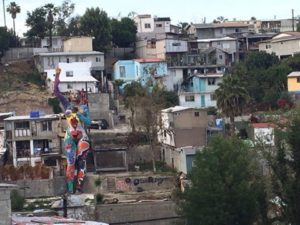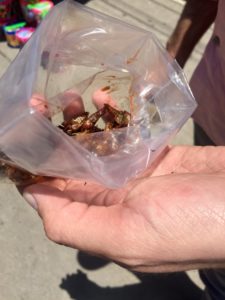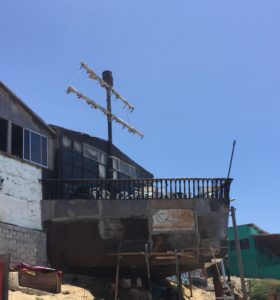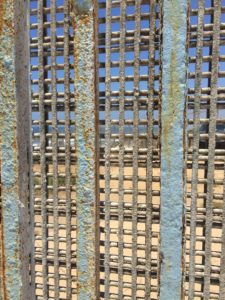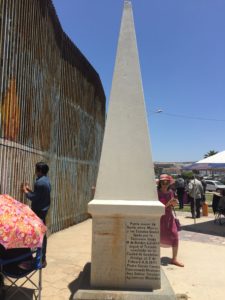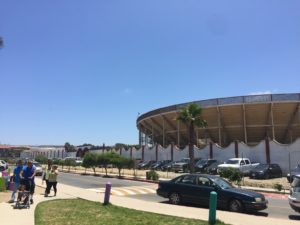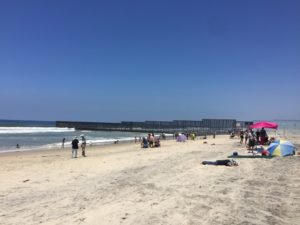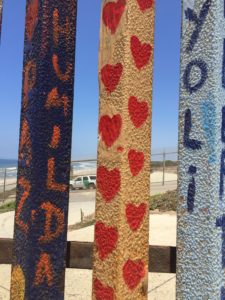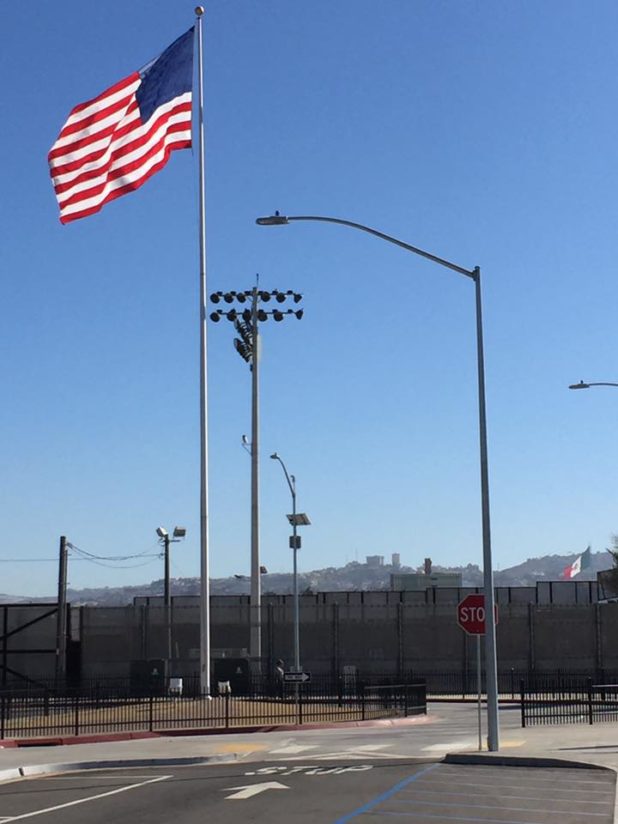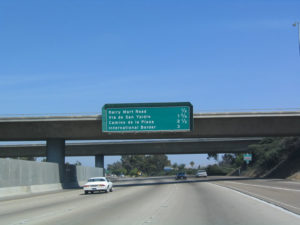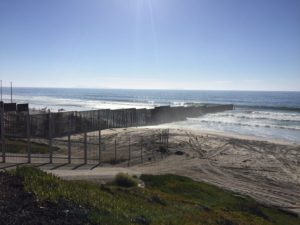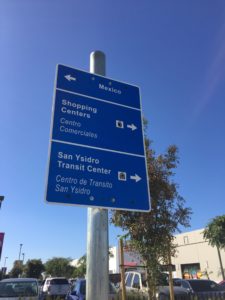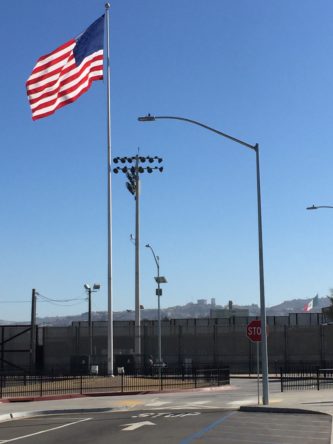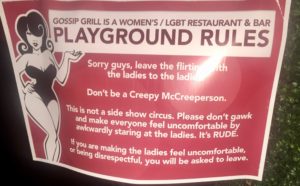[This post is the third in a series of four that chronicles my experiences on a day trip to Baja California Norte on 2 July 2017. Previous installments: Part Zero and Part One.]
We returned to the car after acquiring some electrolyte beverages to combat dehydration from Oxxo, the 7-11 of Mexico. Carlos asked if I would be up for one more stop in Tijuana before setting off towards Ensenada in search of beer and seafood. Feeling adventurous after having just consumed a fried insect, I saw no reason to object. We headed east on Avenida del Agua (yep, aptly named Water Street), which lead us up a steep hill to an entry/exit hut equipped with traffic barriers. Spanish was spoken and Carlos convinced the attendant to open the gate by pushing down forcefully on a big white handle inside the booth. We ascended a dirt road to Casa Manresa, a spiritual retreat and meditation center run by the Jesuits. The center was consecrated in 2007 by Bishop Rafael Romo and named after the Spanish village in Catalonia near where St. Ignatius, founder of the Jesuits, had profound mystical experiences while living in a cave for a year in the early 16th century. [Sometimes I wish that I could live in a Catalonian cave and not talk to anyone, but perhaps not for an entire year. Never mind.] The place had a spectacular panoramic view of Tijuana and the Pacific Ocean. We ambled along the brick path, nodded hola to the caretaker, and skulked away quietly when we saw a religious service in progress through the picture window facing the ocean.
We went back from whence we came down the hill and merged onto Autopista Escenica Tijuana-Ensenada (a.k.a. Carretera Federal 1D), a toll road between Tijuana and Ensenada. The three tolls totaled to approximately 6 USD each way. It is possible to drive 100 km from Tijuana to Ensenada for the price of crossing the Bay Bridge.
Carlos pointed out the Baja Convention Center, another flimflam of a public infrastructure project, on the outskirts of Rosarito. The resorts and nightlife of Rosarito attract many Americans due to the beachy locale and proximity to the border. High-rise condo developments are popping up in fits and starts, but Miami Beach it is not (at least not yet). Delayed or possibly abandoned construction projects spotted the landscape on the ocean side of the roadway.
After we passed Puerto Nuevo, known for its grilled Pacific spiny lobster, the landscape became more dramatic and started to bear more of a resemblance to the Big Sur area of Central California. Because I fervently believe that Pacific spiny lobster is woefully inferior to the Maine equivalent, we opted to bypass Villa Ortega’s, one of the most popular grilled lobster destinations in Puerto Nuevo. The Salsipuedes Bay remains largely free of development. We stopped to take in the view from the southern edge:
As we passed beneath this road sign, I wondered who made the decision only to translate the first half into English and tack on the “Have a Nice Trip” at the end. Furthermore, I have never understood why anyone even bothers with half-assed fake palm tree cell towers. Just screw the LTE microcells to the light poles and be done with it.
On the northern outskirts of Ensenada, Carlos pulled the Mazda off the road into a dirt parking lot and was directed to an obviously vacant parking space by the dude in the fluorescent yellow vest. We had arrived at Aguamala Cerveceria in El Sauzal. Beer! Beer at Last! The literal translation of Aguamala is “bad water” obviously, but it also means “jellyfish” in Latin America– an alternative to “medusa.” Given that the brewery was founded by a marine biologist and is a stone’s throw away from the Pacific Ocean, the place is aptly named. The marketing collateral and labels all featured colorful line drawings of marine creatures.
The Mexican craft beer movement is in its infancy. Difficulties acquiring brewing equipment and ingredients and a draconian tax code that favors beverage giants present structural challenges to small start-up breweries. A Coloradan who started Baja Brewing Company in Cabo San Lucas in 2007 described some of the trials and tribulations of Fighting The Man with the help of a Vice ghostwriter. Mexico is the 6th largest consumer of beer in the world, but its market is dominated by mass-produced light lagers (e.g., Corona, Pacifico, Dos Equis, and Modelo). Although enjoying exponential growth in recent years, craft beer has a measly 1% market share in Mexico.
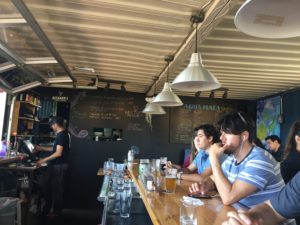 The Aguamala taproom and brewery are built from six stacked shipping containers– a sombrero tip to the craft beer guzzling hipster demographic that makes up a significant fraction of their customer base. Carlos and I are by definition too old to be hipsters and we heavily favor snark over narcissistic displays of irony. As should be self-evident from the existence of Kegomatic.com, we are quite partial to craft beer. At least craft beer that doesn’t taste disgusting. But I digress.
The Aguamala taproom and brewery are built from six stacked shipping containers– a sombrero tip to the craft beer guzzling hipster demographic that makes up a significant fraction of their customer base. Carlos and I are by definition too old to be hipsters and we heavily favor snark over narcissistic displays of irony. As should be self-evident from the existence of Kegomatic.com, we are quite partial to craft beer. At least craft beer that doesn’t taste disgusting. But I digress.
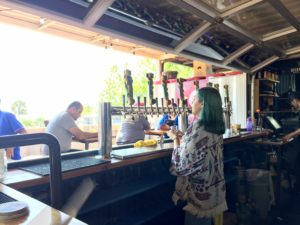 The friendly, green-haired bartender took our order. Being creatures of habit, we did not deviate from our typical taste profiles. Carlos opted as usual for the ridiculously hoppy Astillero Imperial IPA (7.1% ABV, >120 IBUs). I don’t like beers that taste like Pine Sol, so I went for the Marea Roja American Brown Ale (4% ABV, 43 IBUs). The menu claimed the Marea Roja had 42.8 IBUs, a level of precision that strains credibility, so I rounded up to the nearest IBU. I’m not very good at long-winded, flowery descriptions of how beer tastes, so suffice it to say that my first sample of Mexican craft beer was not too hoppy and generally meh.
The friendly, green-haired bartender took our order. Being creatures of habit, we did not deviate from our typical taste profiles. Carlos opted as usual for the ridiculously hoppy Astillero Imperial IPA (7.1% ABV, >120 IBUs). I don’t like beers that taste like Pine Sol, so I went for the Marea Roja American Brown Ale (4% ABV, 43 IBUs). The menu claimed the Marea Roja had 42.8 IBUs, a level of precision that strains credibility, so I rounded up to the nearest IBU. I’m not very good at long-winded, flowery descriptions of how beer tastes, so suffice it to say that my first sample of Mexican craft beer was not too hoppy and generally meh.
Carlos tried to convince me to split an order of sopes de pulpo con pipian (octopus sopas with mole). Given that I feel quite strongly that octopus should not be food, I demurred. We instead compromised on molletes de cabeza rez con chicarrron (molletes with beef cheek and pork rind). Admittedly, that combination sounds questionable, but they were actually delicious. Carlos took a photo of the mollettes, reproduced here so we never forget what we ate and you don’t either.
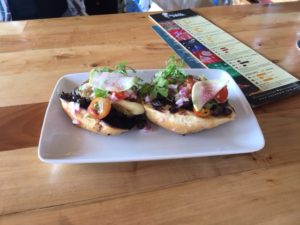 After quaffing down the last of our miniature servings of beer (everything in moderation etc.), we hit the road again and arrived in Ensenada about 20 minutes later. We attempted to beach the Mazda in a sketchy parking lot behind the fish market. The attendant at the entrance confidently assured us that there were plenty of spaces, which turned out to be a bald-faced lie. A vindictive streak came across Carlos. Just as he was gunning for the exit preparing to act indignant and refusing to pay, the parking gods shined mercy down upon us. An old guy driving a beater Toyota pulled out of a space right in front of us.
After quaffing down the last of our miniature servings of beer (everything in moderation etc.), we hit the road again and arrived in Ensenada about 20 minutes later. We attempted to beach the Mazda in a sketchy parking lot behind the fish market. The attendant at the entrance confidently assured us that there were plenty of spaces, which turned out to be a bald-faced lie. A vindictive streak came across Carlos. Just as he was gunning for the exit preparing to act indignant and refusing to pay, the parking gods shined mercy down upon us. An old guy driving a beater Toyota pulled out of a space right in front of us.
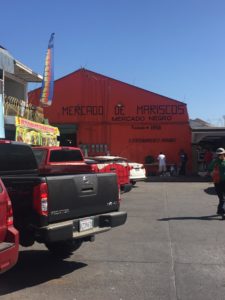 We quickly traversed the very fishy smelling seafood market, which did not bear much of resemblance to Pike Place. The beefcakes in rubber aprons hurling salmon were conspicuously absent. At the time, I wondered what was up with the “mercado negro” on the sign and promptly forgot about it until I pasted this photo into this post. Carlos trawled the Spanish language Internet (pun intended) and learned that from 1957-1967, only a select few fishing companies had authorization from the Mexican Government to sell of certain species of fish, but individual fisherman sold them illegally at markets such as this one. The Black Market moniker stuck after these anti-competitive restrictions went by the wayside. The Mercado de Mariscos in Ensenada was in fact established in 1958, so this explanation seems plausible.
We quickly traversed the very fishy smelling seafood market, which did not bear much of resemblance to Pike Place. The beefcakes in rubber aprons hurling salmon were conspicuously absent. At the time, I wondered what was up with the “mercado negro” on the sign and promptly forgot about it until I pasted this photo into this post. Carlos trawled the Spanish language Internet (pun intended) and learned that from 1957-1967, only a select few fishing companies had authorization from the Mexican Government to sell of certain species of fish, but individual fisherman sold them illegally at markets such as this one. The Black Market moniker stuck after these anti-competitive restrictions went by the wayside. The Mercado de Mariscos in Ensenada was in fact established in 1958, so this explanation seems plausible.
I have a soft spot for signs that state the obvious, although I must confess that the incongruity of the background being red and the hydrant being white bothers me more than it should. Nevertheless, the fact that Carlos’s t-shirt purchased at the Wal-Mart mothership in Bentonville, AR matched both the sign and the hidrante itself enhanced the composition considerably, if I do say so myself.
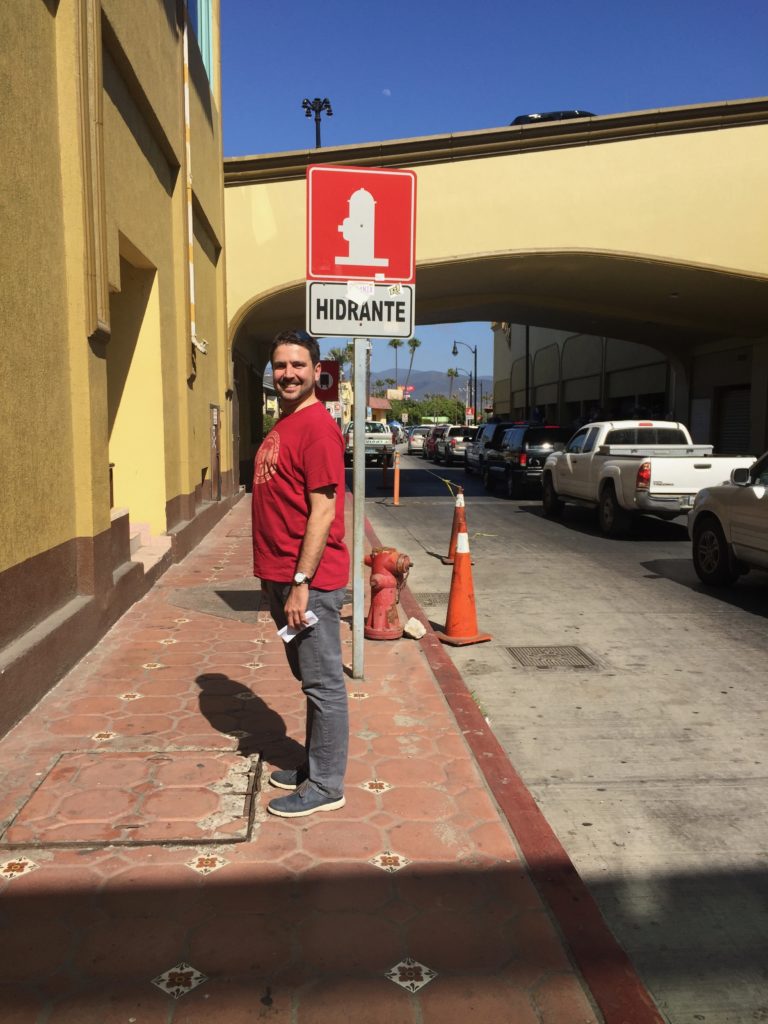
After capturing this photographic wonder, we wended our way through the backlot of a Starbucks in search another brewery, Wendlandt Brewpub, on Blvd. Costero, one of the main drags in Ensenada. No pithy comments on the quality of the beer are forthcoming because the place was closed. Who in their right mind wouldn’t want to drink beer on a hot Sunday afternoon? Alas, a lost opportunity to part us from our pesos. So onwards we wandered.
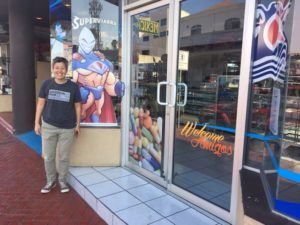 The friendly ladies behind the counter at the SuperViagra pharmacy (Welcome Amigos!) directed us to the vaunted Mariscos El Guero food cart around the corner. The pigeon perched on the roof did not immediately inspire confidence, nor did the “seafood supply truck” parked across the street.
The friendly ladies behind the counter at the SuperViagra pharmacy (Welcome Amigos!) directed us to the vaunted Mariscos El Guero food cart around the corner. The pigeon perched on the roof did not immediately inspire confidence, nor did the “seafood supply truck” parked across the street.
However,the glowing Yelp reviews and the teeming hordes of locals and Mexican tourists made me less incredulous. We both opted for two medium classic shrimp cocktails, which came in one of four sizes. The woman taking orders worked with admirable efficiency, explaining all of the available options, shepherding people through the line, and collecting their money quickly. Additional staff took orders on the opposite side of the truck for tostadas and oysters on the half-shell, which were dished out with much more expediency. We had ample opportunity to watch the staff prepare the cocktails to order. The liberal amounts of pico de gallo, avocado, and lime juice resulted in hands-down the tastiest shrimp cocktail I have ever consumed. And being a seafood-loving native of New England, I have consumed many in my lifetime.
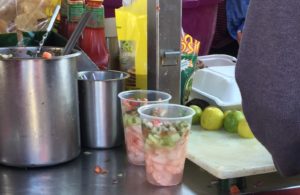 Carlos was crushed when he learned that they were out of pulpo. (To state the obvious, I was perfectly content with the shrimp status quo.) But then word spread amongst the patrons waiting to be served that another batch of pulpo was on its way and that anyone could supplement their half-eaten cocktail with some chopped up tentacles once it arrived. We loitered around the cart for what seemed to me an excessively long time. As we snarfed down our cocktails, a guy drove by who has much cooler Volkswagens (of varying sizes) than I do or ever will. I breathed a sigh of relief when Carlos finally gave up on the pulpo and begrudingly agreed to go somewhere else.
Carlos was crushed when he learned that they were out of pulpo. (To state the obvious, I was perfectly content with the shrimp status quo.) But then word spread amongst the patrons waiting to be served that another batch of pulpo was on its way and that anyone could supplement their half-eaten cocktail with some chopped up tentacles once it arrived. We loitered around the cart for what seemed to me an excessively long time. As we snarfed down our cocktails, a guy drove by who has much cooler Volkswagens (of varying sizes) than I do or ever will. I breathed a sigh of relief when Carlos finally gave up on the pulpo and begrudingly agreed to go somewhere else.
We soon encountered an abandoned Party Bus. Perhaps it too was observing the Sabbath along with its friends at Wendlandt Brewpub.
Another discount pharmacy we happened upon had American flags plastered all over it. I wonder why? Lecherous old gringos with erectile dysfunction who don’t want to pay full price, that’s why! The establishment sold acne medication and antibiotics for good measure. A single dose of a potent antibiotic does eradicate most STDs, after all. Imagining lecherous old gringos with pimpled complexions wasn’t that much of stretch either. It all made perfect sense.
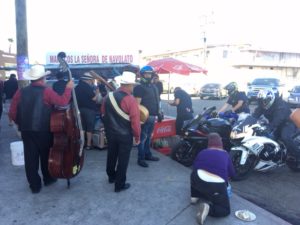 The same cannot be said for the scene we subsequently witnessed at one of Mariscos El Guero’s competitors around the corner. I suppose mariachi bands need seafood to snack on too. And chihuahua-owning riders of crotch rockets need to feed and water their beloved pooch (said beast was obscured by the crouching woman in the purple shirt).
The same cannot be said for the scene we subsequently witnessed at one of Mariscos El Guero’s competitors around the corner. I suppose mariachi bands need seafood to snack on too. And chihuahua-owning riders of crotch rockets need to feed and water their beloved pooch (said beast was obscured by the crouching woman in the purple shirt).
Before returning to the sketchy parking lot and heading back north to Tijuana, we took one final stroll along the boardwalk adjacent to the ocean. It was awash in Mexican families enjoying a leisurely Sunday afternoon along with a smattering of American tourists and had a carnival-like atmosphere, complete with a troupe of Mexican folk dancers and a random guy in a Woody costume.
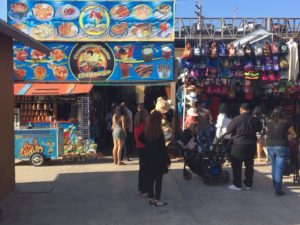 I felt an overwhelming urge to capture an image of this quintessential example of Mexican beach food stall advertising. It is perilously close to the absolute apex of tackiness. After ODing on this explosion of kitsch, we decided to retreat back to Tijuana.
I felt an overwhelming urge to capture an image of this quintessential example of Mexican beach food stall advertising. It is perilously close to the absolute apex of tackiness. After ODing on this explosion of kitsch, we decided to retreat back to Tijuana.
As Carlos piloted the Mazda north, the Sagrado Corazon de Jesus, a 75 foot tall steel and fiberglass statue that weighs 40 tons, came into view perched on a hill in El Morro, 6 miles south of Rosarito. He has even secured the adoration of the Yelpers. I spontaneously felt the need to photograph Him in his Hazy Splendor, perhaps subconsciously suspecting, for some inexplicable reason, that it might be somehow fitting for this post to both begin and end with Christian iconography.
Coming up next in Baja California or Bust: Part Three (the final installment)– we return to Tijuana to eat and drink our way down Avenida Revolución and circuitously make our way back across the border to San Diego.

